Designing and create your own sunglasses
In light of the increasing interest in designing sunglasses and creating own eyewear, various resources are available for those who want to learn how to design and make sunglasses. Custom design sunglasses and creating your own sunglasses brand are becoming popular entrepreneurial endeavors. Eyewear design software and sunglass templates can assist in bringing your unique vision to life. Online platforms even allow you to design your own sunglasses with a logo, making it easy to start your own sunglass line.
For those who want to pursue a career in glasses design, eyewear design courses can provide essential skills and knowledge. With the right guidance, you can learn how to customize sunglasses, create custom sunglasses, and even start your own sunglasses brand. Sunglasses sketching, easy sunglasses drawing, and following sunglass patterns can help you refine your design skills and craft the perfect pair of eyeglasses.
And, it is essential to familiarize yourself with the various components of eyeglasses, measurement methods, terminology definitions, human facial features, key points in frame design, testing requirements, and reference standards. By understanding these elements, you can ensure the creation of comfortable, stylish, and functional eyewear that suits a wide range of individual preferences and needs.
In conclusion, as people become more focused on the comfort and aesthetics of eyewear, designing and creating your own sunglasses is a growing trend. By understanding the relevant parameters of eyeglass frames, using design software, and learning how to start your own sunglass line, you can turn your passion for eyewear into a successful business or personal hobby.
Table of contents
2.1 Baseline Notation Method
2.2 Box Notation Method
3.1 Terminology and definitions for eyeglass frame measurement items
3.2 Dimensional notation for eyeglass frame measurement items
4.1 Human head and face size
4.2 Correspondence between eyeglass frame and head-facial measurement items
4.3 Scientific guidance for wearing eyeglasses properly
1. Spectacle frame parts for designing sunglasses
2. How to measure sunglasses when designing glasses
2.1 Baseline notation method: This is a method for measuring eyeglass frames using the bisector of the parallel tangent lines that pass through the highest and lowest points on the inner edges of the left and right frames (or lenses). All vertical measurements start from the baseline.

The baseline notation method uses “-” as the symbol, for example, if the frame specification is 52-20-140, then “52” represents the lens frame size, “20” represents the bridge size, and “140” represents the temple length. (The unit is usually in millimeters, abbreviated as mm.)
2.2 Box notation method: The box method for measuring eyeglass frames has been recognized by the International Organization for Standardization (ISO) and all its members. As the name suggests, the box method involves drawing an outer tangent rectangle (box) that is tangent to the lens (lens bevel), and for the corresponding frame, this outer tangent rectangle is also tangent to the eye rim groove of the frame.

The box notation method uses “□” as the symbol, for example, if the frame size is 52 □ 17 – 140. Currently, the box method for measuring eyeglass frames has been recognized by the International Organization for Standardization (ISO) and all its member countries.
2.3 Comparison between the baseline notation method and the box notation method
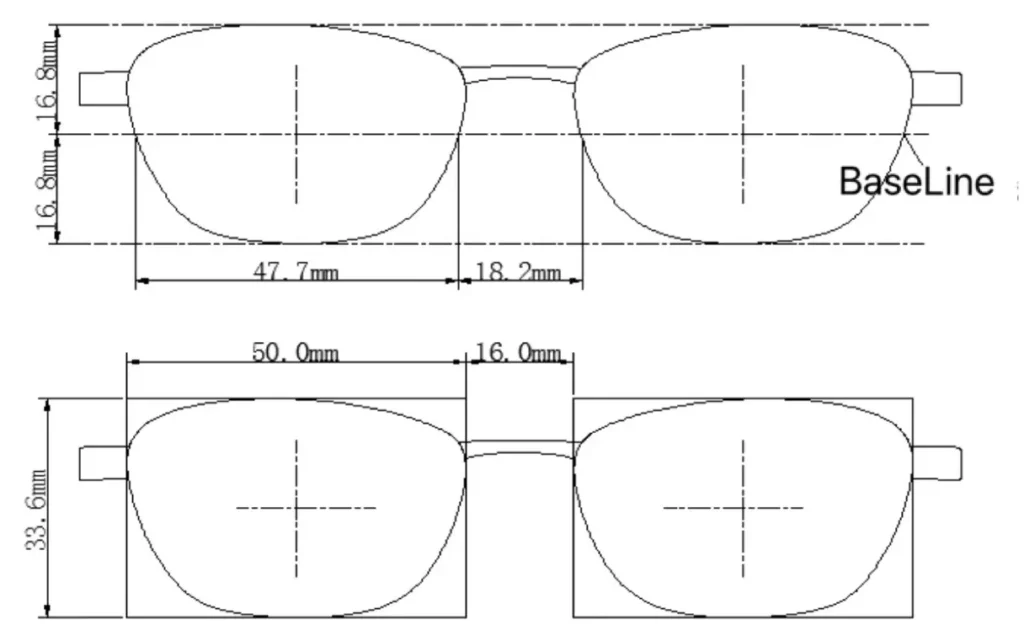
From the diagram above, it can be seen that for the same drawing, the lens length measured by the box method is greater than that measured by the baseline method, and the bridge size is smaller than that measured by the baseline method. The lens height is the same for both methods. It is evident that the box method can accurately indicate the length and height of the lens, but it cannot accurately reflect the spacing of the nose pad positions. On the other hand, the baseline method can reflect the spacing of the nose pad positions but does not accurately represent the lens length.
3. Definition and identification of glasses measurement items
3.1 Terminology and definitions for eyeglass frame measurement items (Using the box method for measurement)
3.1.1 Frame Total Width: The distance between the outermost points of the left and right end pieces when viewed from the front (including the lengths of the left and right lenses, the bridge length, etc.).
3.1.2 Frame Total Length: The distance between the top of the outer front of the frame and the end of the temple arm.
3.1.3 Lens Length: The maximum size of the lens in the horizontal direction. Often denoted by the code “A“.
3.1.4 Lens Height: The maximum size of the lens in the vertical direction. Often denoted by the code “B“.
3.1.5 Lens Spacing: The minimum distance between the left and right lenses. Often denoted by the code “DBL“.
3.1.6 Frame Geometric Center: The distance between the center points of the left and right lenses. Often denoted by the code “FPD“.
3.1.7 Temple Length: The distance from the center of the hinge hole on the temple to the end of the temple tip.
3.1.8 Temple Bend Length: The distance from the center of the hinge hole on the temple arm to the “ear attachment point OBS” on the temple arm.
3.1.9 Temple Drop Length: The distance from the “ear attachment point OBS” on the temple arm to the end of the temple arm. This is commonly referred to as the “temple drop length”.
3.1.10 Temple Drop Angle: The angle between the temple drop length portion and the temple extension line when viewed from the side.
3.1.11 Temple Drop Inward Angle: The angle between the axis of the temple drop length portion and the vertical line when viewed from above, commonly referred to as the “drop inward angle”.
3.1.12 Lens Frame Tilt: When wearing the eyeglass frame and looking straight ahead, the angle between the straight line connecting the upper and lower ends of the front frame and the vertical line when viewed from the side.
3.1.13 Pantoscopic Angle: The angle between the straight line from the center point of the joint between the temple arm and the end piece to the “ear attachment point OBS” on the temple arm and the lens “normal line”.
3.1.14 Nose Pad Spacing: The straight-line distance between the intersection points of the eye rim of the left and right lens frames at the bridge and the vertical centerline of the lenses.
3.1.15 Nose Pad Height: The vertical distance from the highest point of the nose pad leaf when viewed from the side to the outer surface of the lens frame.
3.1.16 Nose Pad Front Angle: The angle between the long axis of the nose pad leaf and the vertical line when viewed from the front.
3.1.17 Nose Pad Top Angle: The angle between the long axis of the nose pad leaf and the back plane of the lens frame when viewed from the side.
3.1.18 Nose Pad Diagonal Angle: The angle between the plane of the nose pad leaf and the normal of the lens frame plane when viewed from above.
3.1.19 Temple Outward Angle: The angle between the connecting line of the left and right hinge axes and the temple arm when the temple arms are opened to their limit when viewed from above.
3.1.20 Frame Curvature: The radius of the arc passing through the endpoints of the left and right lenses when viewed from above, which represents the curvature of the frame.
3.1.21 Lens Plane Angle: The angle between the planes of the left and right lenses when viewed from above.
3.1.22 Temple Bend Spacing: The distance between the inner sides of the left and right temple bends when viewed from above.
3.1.23 Temple End Spacing: The distance between the inner sides of the left and right temple ends when viewed from above.
3.2 Dimensional notation for eyeglass frame measurement items
4. Human Head and Face Features and Glasses Wearing
4.1 Human head and face size
The data in the table below comes from Wikipedia, which is used as a reference when designing our glasses, but at the same time, we will conduct a targeted analysis for our audience.

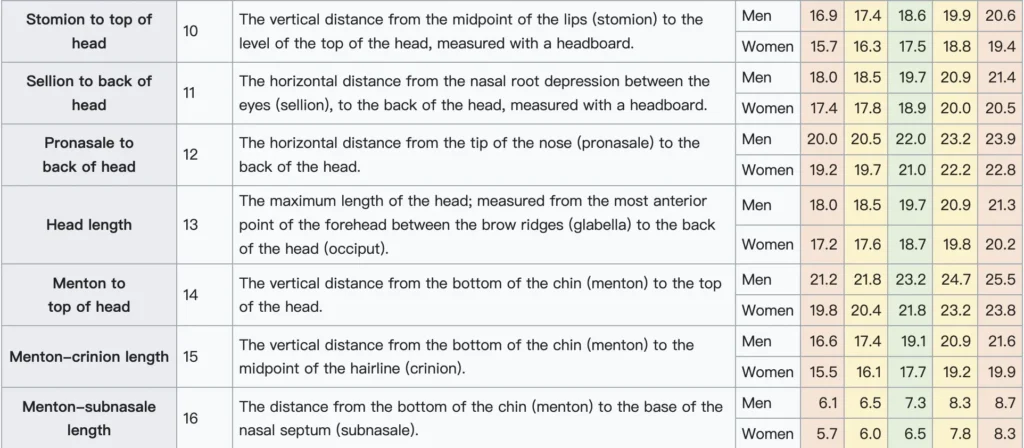
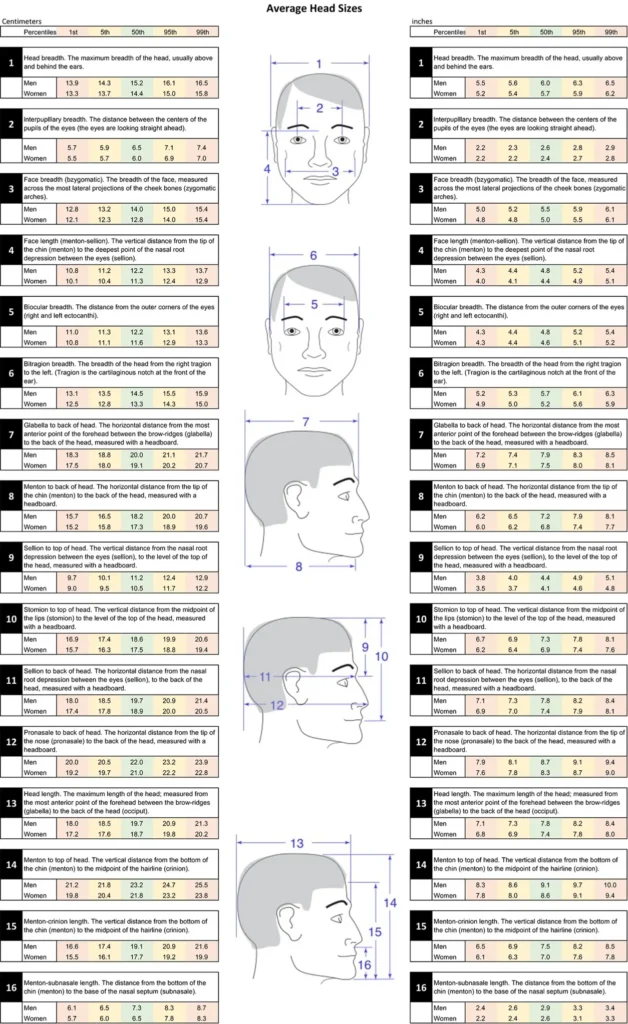
When we are designing glasses, we suggest working with the sunglasses manufacturer to discuss more when we make sunglasses technical drawings, and at the same time strictly follow up the sunglasses production process to ensure that all size are implemented.
4.2 Correspondence between eyeglass frame and head-facial measurement items

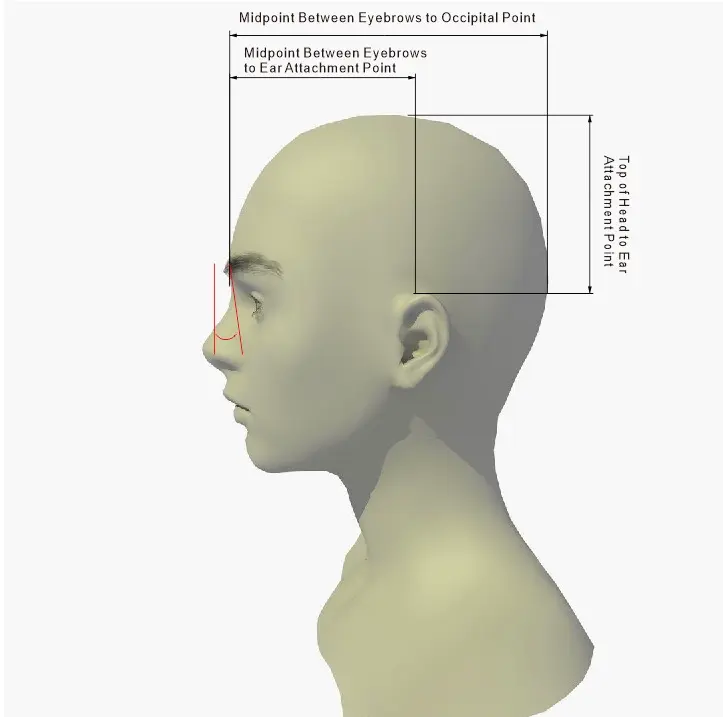
- Face Width: The straight-line distance between the left and right cheekbones.
- Full Head Height: The vertical distance between the top of the head and the chin.
- Outer Eye Width: The straight-line distance between the outer corners of the left and right eyes.
- Inner Eye Width: The straight-line distance between the inner corners of the left and right eyes.
- Pupillary Distance: The straight-line distance between the centers of the left and right pupils when looking straight ahead.
- Morphological Face Length: The vertical distance between the bridge of the nose and the chin.
- Top of Head to Midpoint Between Eyebrows: The vertical distance from the top of the head to the midpoint between the eyebrows.
- Eye Top Height: The vertical distance from the top of the head to the inner corner of the eye.
- Midpoint Between Eyebrows to Occipital Point: The horizontal straight-line distance from the midpoint between the eyebrows to the occipital point (different from head length).
- Midpoint Between Eyebrows to Ear Attachment Point: The horizontal straight-line distance from the midpoint between the eyebrows to the ear attachment point.
- Top of Head to Ear Attachment Point: The vertical distance between the top of the head and the ear attachment point.
4.3 Scientific guidance for wearing eyeglasses properly
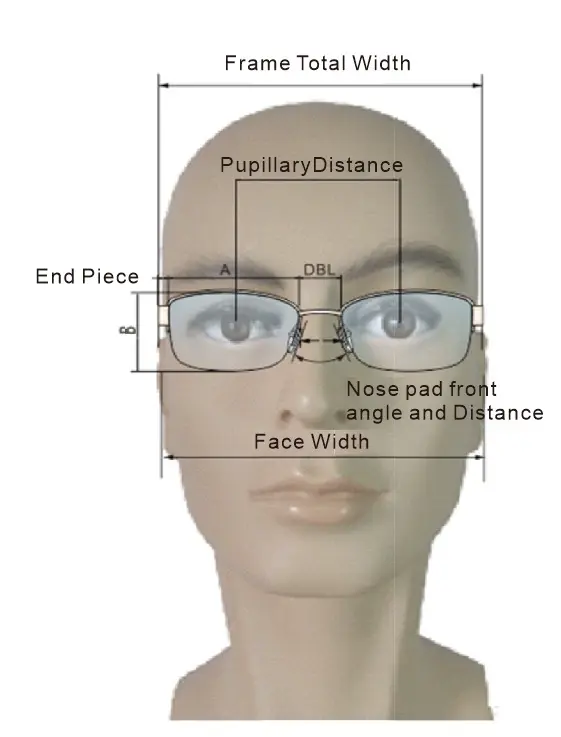
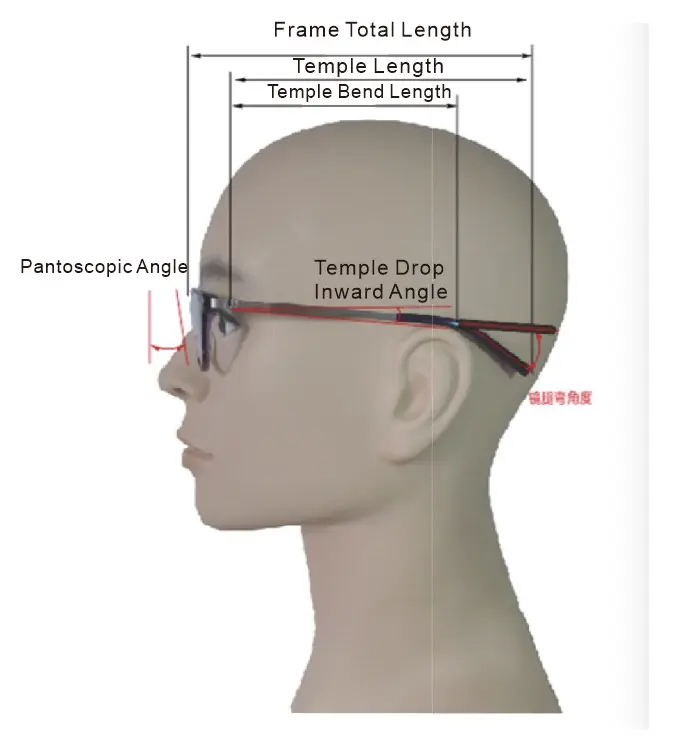
Frontal Wearing Instructions:

- When wearing eyeglasses, the frame width should be as close as possible to the wearer’s face width, and the geometric center distance of the frame should be close to the wearer’s pupillary distance. The center of the pupil should be near the centerline of the B position of the lens, ensuring that the horizontal and vertical deviations of the lens optical center are within the acceptable range.
- If the frame width is too large, the eyeglasses may easily slip off when worn; if the frame width is too small, the wearer’s face will bear increased pressure from the frame, affecting comfort and potentially causing frame deformation. Frame width is also related to the structure; relatively speaking, spring hinge frames have a slightly smaller width than ordinary hinge frames because the temples of spring hinge frames have an outward tension.
- Additionally, the front angles and spacing of the left and right nose pads should be consistent with the wearer’s nose shape to ensure comfortable eyeglass wear. Nose pads come in adjustable and fixed types. Adjustable nose pads can be adjusted according to the wearer’s nose shape, while fixed nose pads require a good fit with the wearer’s nose shape to ensure comfort.
Side View Wearing Instructions :

- From a side view of the human body, the upper edge of the eye socket is more protruding than the lower edge. When wearing eyeglasses, the lens frame needs to be tilted to ensure comfortable and aesthetically pleasing wear. If the lens frame tilt is too large or too small, it can cause discomfort and result in astigmatism. The tilt of the lens frame is directly related to the tilt of the temples, and their relationship changes with the position of the ear attachment.
- When wearing the eyeglass frame, ensure that the curve of the temple is at the position of the ear. The temple’s downward angle is typically 35°±5° (excluding sports models). If the angle is too small, the frame may slip off easily; if the angle is too large, it can make putting on and taking off the glasses inconvenient. The radius of the temple’s curved angle is usually R50±5.
- Additionally, when viewed from the side, the height of the nose pads should ensure that the wearer’s cornea is 12mm away from the bottom of the lens, also known as the “vertex distance.” Adjustable nose pads can meet the vertex distance requirements by adjusting the top angle of the pad, achieving optimal visual effects. Fixed nose pads, on the other hand, require a good fit with the wearer’s nose shape to ensure comfort.
Top View Wearing Instructions :
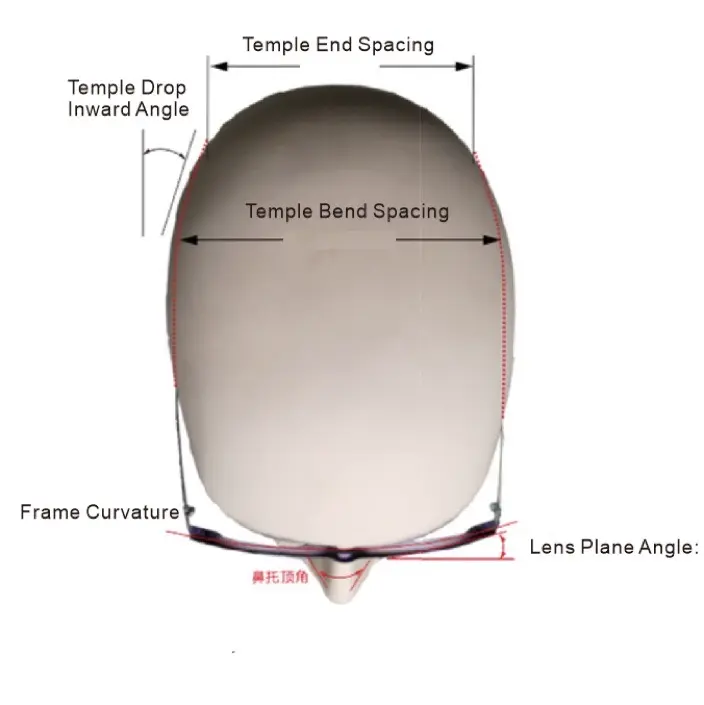
- When wearing eyeglasses, viewed from the top, the distance between the left and right temples and the vertical inner angle of the temples should fit the wearer’s head shape to ensure stable, comfortable wear and to prevent the glasses from slipping. The temple spacing should be adjusted according to the frame structure. For example, the temple spacing of ordinary hinge frames should be 4-8mm larger than that of spring hinge frames, and the temple spacing of spring hinge frames should be 6-10mm larger than that of “ultra-elastic” frames (depending on the frame’s elasticity).
- From a top view, the top angle of the nose pads should fit the wearer’s nose sides to ensure wearing comfort. If they do not match, pressure marks from the nose pads may appear on the nose.
- Additionally, the angle between the lenses and the curvature of the lens frame should be determined according to the frame’s functional type. The curvature of ordinary prescription frames should be smaller than that of sunglasses. (See the subsequent design instructions for more details)

5. How To Designing Sunglasses
I heard a story about the director of Japan’s Mitsubishi Group who originally wore a very old pair of glasses. One day, an eyeglass merchant approached him and said, “Glasses are an accessory on your face. As one of Japan’s most successful businessmen, you often meet with Europeans and Americans. Wearing old, worn-out glasses doesn’t suit you anymore! As a Japanese person frequently seen by foreigners, you represent not only Mitsubishi and yourself but also Japan’s image. You should get a pair of gold-rimmed glasses from me, as they would match your status.” The director happily agreed.
This was not only a perfect sales pitch but also an interpretation of a product – eyeglasses. As an eyeglass user myself, I believe that everyone who gets glasses tries on frames from hundreds of options. This process is often prioritized over the important lenses. This shows how crucial it is to have a suitable and aesthetically pleasing eyeglass frame.

5.1 Eyeglass frame design principles
- Stability : Stability in eyeglasses means keeping them balanced and steady during use. It’s important for users because it affects how the glasses feel and perform while being worn. To improve stability, make sure the frame fits well on the head, the temples and nose pads are comfortable, and the lenses are at the right distance from the eyes. This ensures better comfort and vision for the wearer.
- Mechanical Properties : During use, eyeglasses are subject to the force of gravity, which is related to the mechanical effects found in physical properties. However, more importantly, the design of the eyeglasses should have a structural form that suits these mechanical characteristics. This ensures that the glasses remain stable and comfortable on the wearer’s face while resisting the forces acting upon them.
- Comfort : Eyeglass wearers can clearly feel the comfort of their glasses. While glasses bring convenience to people’s lives, comfort is also very important. As an assistive tool for those with nearsightedness, glasses should not become a burden. A well-designed frame that fits the wearer’s face shape, along with appropriate temple curves, nose pads, and lens distance, can enhance the overall comfort of the eyeglasses, making them a pleasure to wear.
- Aesthetics : The eyes are the window to the soul, and choosing suitable eyeglasses can highlight one’s personal style. Unique design elements in the frame can make the glasses visually appealing and enhance the wearer’s overall appearance. Selecting the right shape, color, and style of the eyeglass frame can complement the wearer’s facial features and help express their individuality.
5.2 Front rim design of eyeglass frames
Principle: There should be no fixed limitations on the shape, and the size should meet the wearer’s requirements. The main points are as follows:
5.2.1 Lens Frame Length : When designing the lens frame length, consider the wearer’s “eye fissure” length. The length of the lens frame must be greater than the length of the “eye fissure.” This ensures that the lenses adequately cover the wearer’s eyes, providing proper visual support and a comfortable fit.

5.2.2 Lens (eye rim) Height : When designing the height of the lens frame, first determine the position of the wearer’s pupil within the frame. Aim to have the center of the pupil aligned with the vertical centerline of the lens frame. Additionally, from an aesthetic perspective, the upper edge of the lens (eye rim) should not exceed the horizontal line at the “midpoint between the eyebrows.” It can be level with or below this horizontal line. Consider these factors comprehensively to ultimately determine the height of the lens (eye rim) frame.

5.2.3 Frame Front Width : When designing the frame front width, consider the facial features of the eyeglass wearer, such as face width, outer eye width, and pupil distance, among others. The relationship between these facial parameters and the eyeglass frame is as follows:
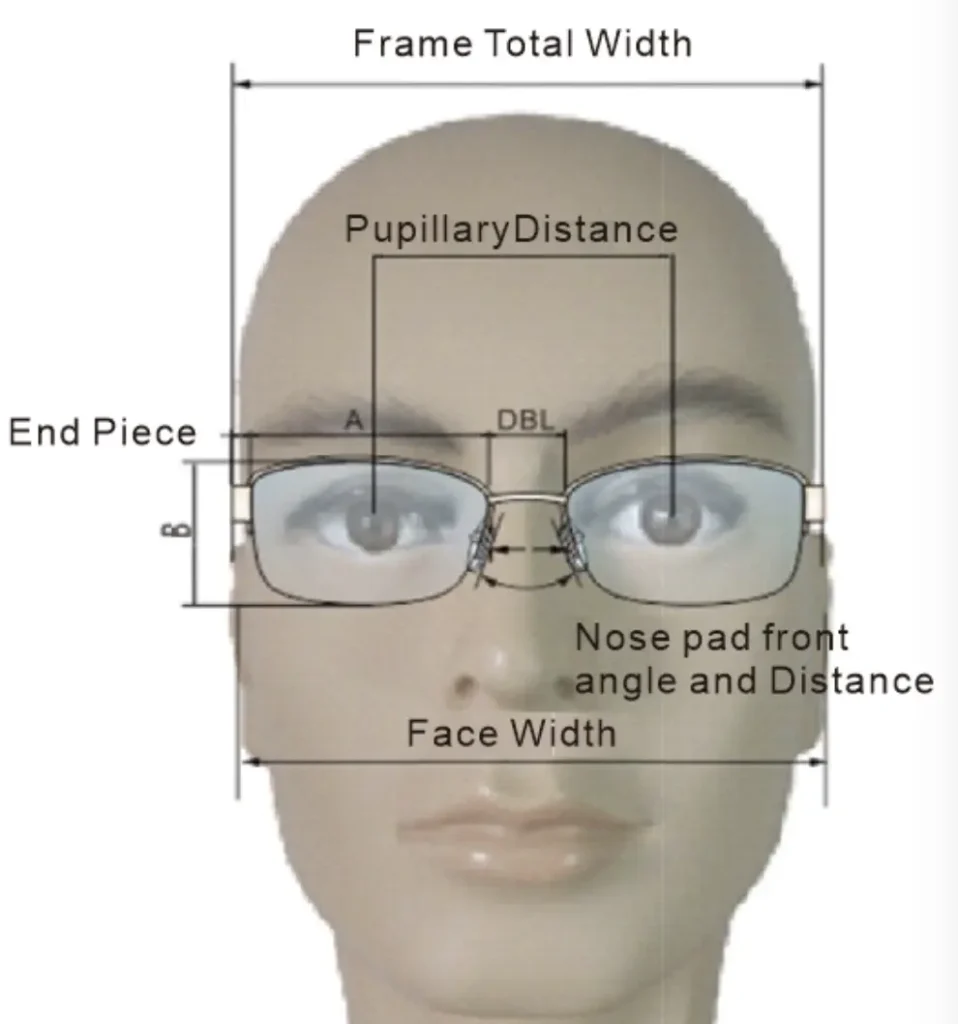
- Face Width and Frame Total Width : From an aesthetic perspective, the frame width should match the face width of the eyeglass wearer, blending the frame with the wearer’s facial features. This ensures a comfortable and visually pleasing fit. (The average face width for adults is 143mm for men and 136mm for women.) From a comfort standpoint, it is essential first to ensure that the frame is stable, secure, and not prone to slipping. Moreover, the frame should not be too tight, causing discomfort by squeezing the head.
- Outer Eye Width and Outer Width of Both Lens (eye rim) Frames : The outer width of both lens (eye rim) frames must be greater than the outer eye width,This ensures that the frame provides adequate coverage of the wearer’s eyes and offers a comfortable and secure fit.
- Pupil Distance, Lens Length, and Bridge Length : When designing, first consider the target group’s pupil distance. The length of a single lens plus the bridge length should be as close as possible to the eyeglass wearer’s pupil distance.This ensures that the glasses are properly aligned with the wearer’s eyes, providing optimal vision correction and comfort.
5.2.4 Frame Front Nose Pad Support : The shape of the nose pad support area of the lens (eye rim) frame should conform to the facial features of the target group, ensuring a stable and comfortable fit. Nose pad supports can be divided into fixed and adjustable types. Adjustable nose pad supports can be adjusted according to the wearer’s facial features, while fixed nose pad supports cannot be adjusted. Therefore, the design of the lens (eye rim) frame should take into account the shape and spacing of the nose pad support area. (During the design process, a standard nasal bone model can be used for fitting tests to ensure that it meets the wearing requirements)
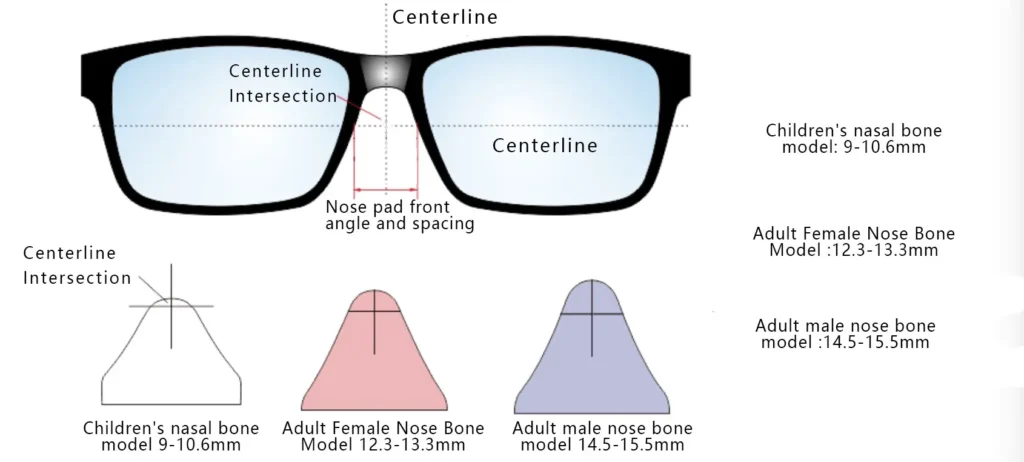
5.2.5 Summary of front frame design:
- Frame eye shape has no fixed limitations and can be chosen based on the wearer’s face shape.
- The overall length of the front frame should correspond to the wearer’s face width. The length of a single lens (eye rim) frame plus the bridge length should be as close as possible to the wearer’s pupil distance.
- The center of the wearer’s pupil should be as close as possible to the vertical centerline of the lens (eye rim) frame height.
- Use a nasal bone model for fitting tests at the nose pad support area of the lens (eye rim) frame to ensure that the frame meets the wearer’s requirements.
5.3 Curvature and lens angle design for eyeglass frames
When designing the lens frame curvature and lens angle, consider the target group’s brow contour in a top-down view and the frame’s functionality. The lens frame curvature and lens angle are correlated; the greater the curvature, the larger the angle. Conventional lens frame curvature and lens angles are as follows:

- 400C-500C angle of 5-8 degrees (commonly used for prescription eyeglasses frames)
- 600C angle of 9-12 degrees (commonly used for regular sunglasses frames)
- 800C angle of 13 degrees and above (commonly used for sports eyeglasses frames and other special frames)
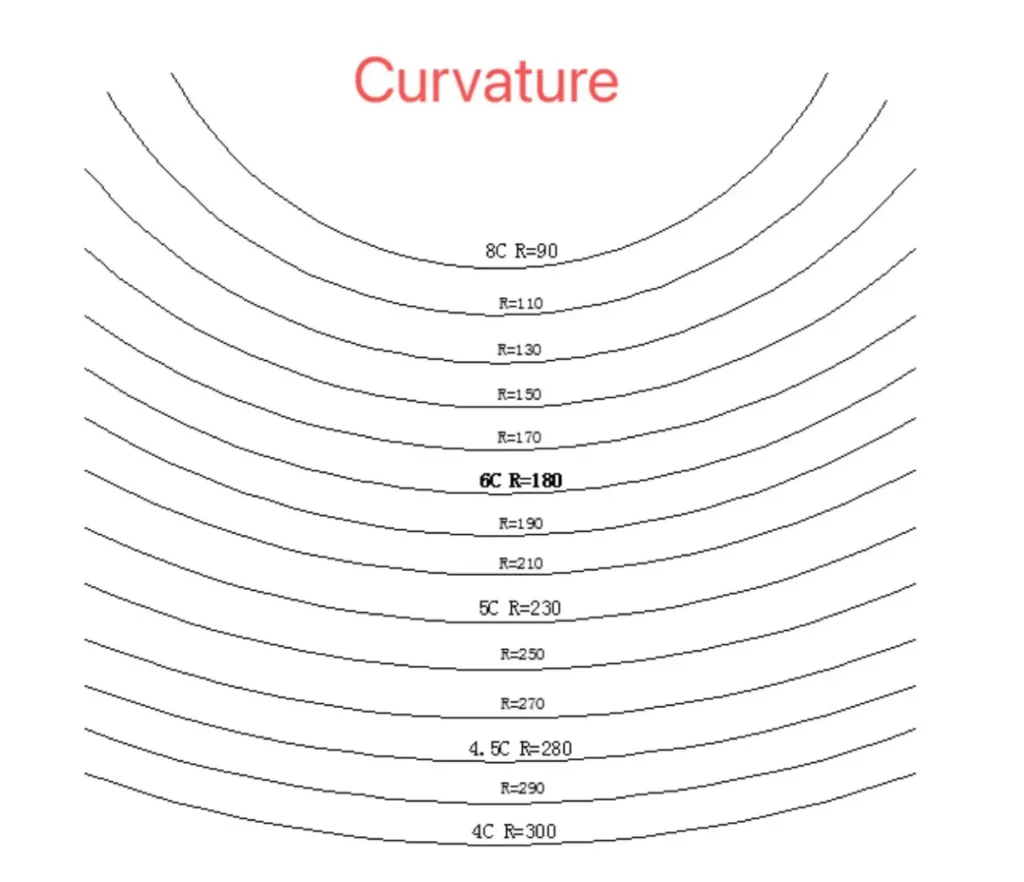
These curvature and angle ranges ensure that the eyeglass frames provide the appropriate coverage and functionality for their intended use, whether it is for prescription glasses, sunglasses, or sports and specialty eyewear.
5.4 Nose pad design for eyeglass frames
Ensure the eyeglass frame is comfortable and stable when worn.
When designing the nose pad support, consider the target group’s nasal features to meet their wearing requirements. The main aspects to consider are the distance between the two nose pad supports, the front angle of the nose pad support, the top angle of the nose pad support, the oblique angle of the nose pad support, the position of the nose pad support, and the height of the nose pad support. The details are as follows:
5.4.1 Distance between the two nose pad supports: The distance between the two nose pad supports has already been determined during the design of the front frame of the eyeglasses.
5.4.2 Nose Pad Angles : There are three angles to consider for the nose support – the front angle, the top angle, and the oblique angle.

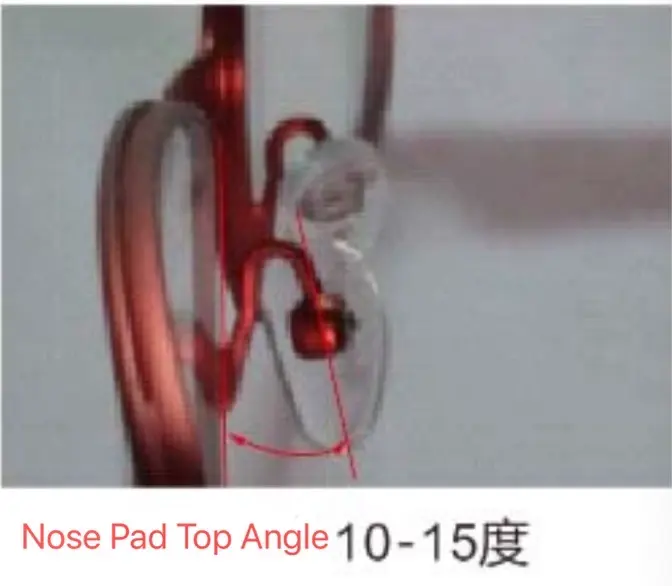
5.4.3 Nose Pad Support Position : The upper part of the nose consists of hard “nasal bones,” while the rest is made up of soft tissue. When wearing glasses, the nose pad support should be positioned on the wearer’s “nasal bone” to ensure a stable fit and prevent the glasses from slipping. The position of the nose pad support directly determines the position of the lens frame on the wearer’s face. Considering the facial features of the human head, the design position can place the “most prominent point” of the nose pad support inward, aligned with the horizontal midline of the B position of the lens (eye rim)frame (the baseline of the baseline method).
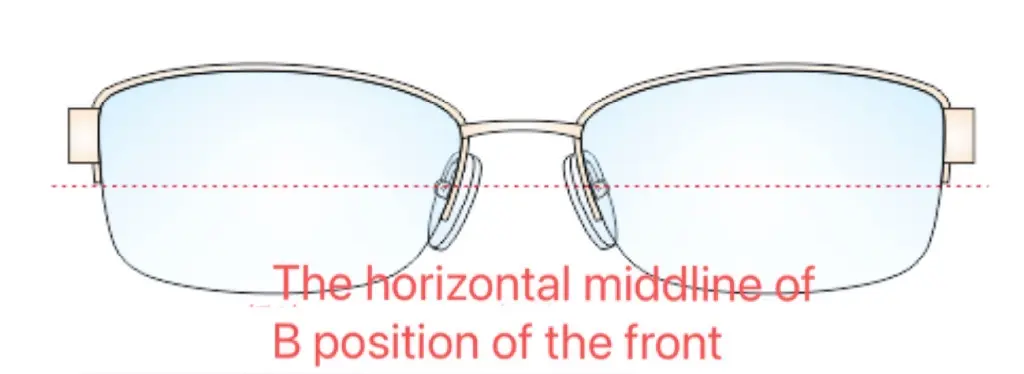
5.4.4 Nose Pad Height : When designing the nose support, consider the vertex distance (usually 12mm). The vertex distance refers to the distance between the back vertex of the lens and the cornea. This consideration helps ensure proper positioning and comfort for the wearer.
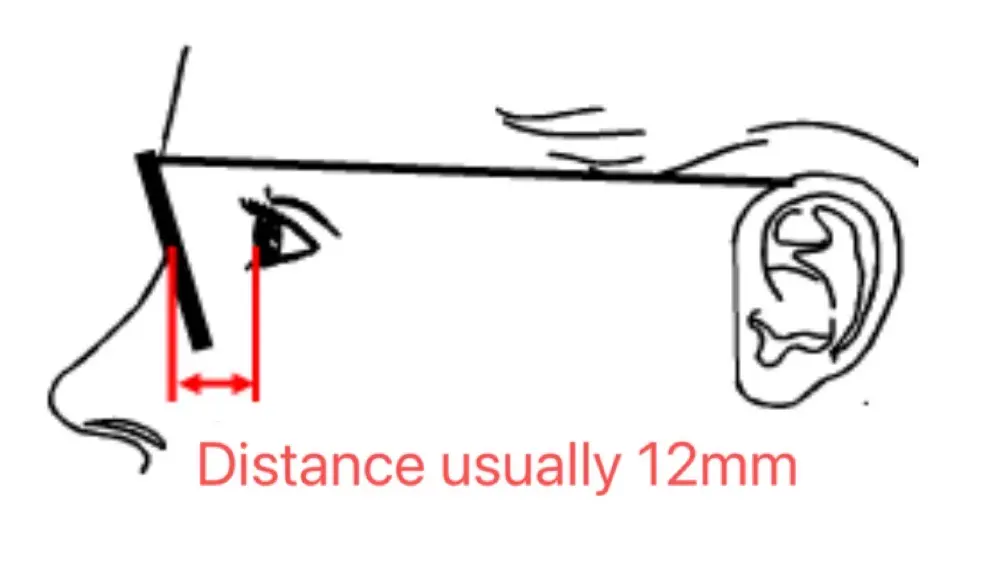
5.5 Temple design for eyeglass frames
Ensure the eyeglass frame is comfortable and stable when worn.
5.5.1 Temple Length : This refers to the distance between the hinge hole center and the end of the temple. When designing the temple length, consider the target group’s head length, as well as the frame’s curvature and the type of temple tips. Reference szie for frame total length:
- Children’s frames (7-15 years old): 130-140mm
- Adult frames: 140-150mm
Taking these factors into account will help create eyeglass frames that provide a comfortable and secure fit for the intended age group.

Curved end piece:
Children’s frames temple length: 110mm-125mm
Adult frames temple length: 130mm-145mm
Straight end piece :
Children’s frames temple length: 115mm-130mm
Adult frames temple length: 135mm-150mm
These suggested temple lengths for both curved and straight temple tips can ensure a comfortable and secure fit for children and adult eyeglass frames.
5.5.2 Temple curvature design: Ensure the eyeglass frame is comfortable, secure, and convenient to put on and remove.
- Temple Drop Length:
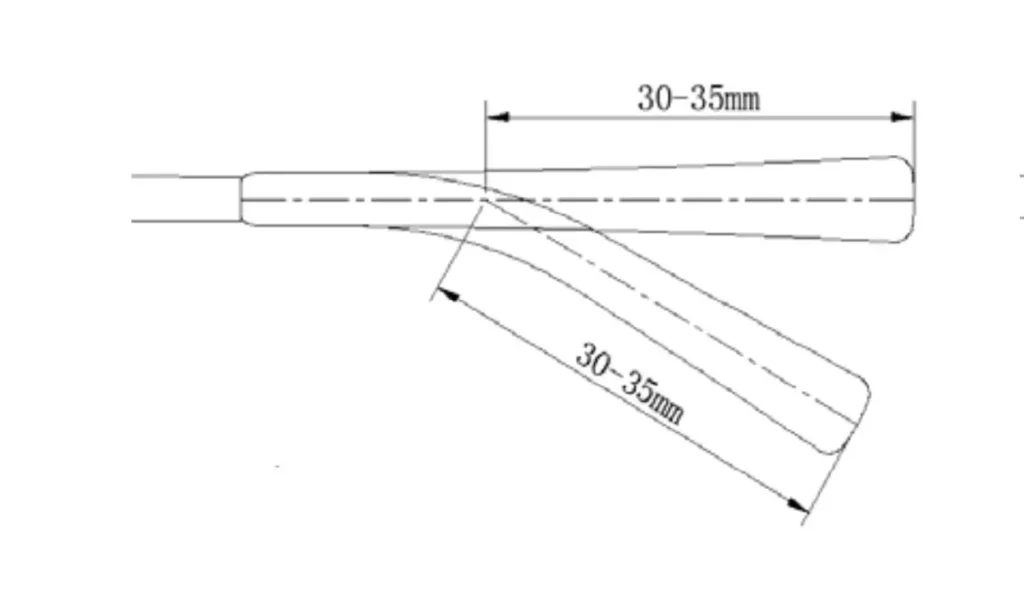
- Temple Drop Angle:
Temple drop angle and temple spacing: Design both the pantoscopic angle and temple spacing to ensure a comfortable and secure fit for the eyeglass frame. The pantoscopic angle and temple spacing should be determined according to the frame’s “elasticity.” The pantoscopic angle and temple spacing for ultra-flexible frames differ from those of regular frames.
- Temple Drop Inward Angle:
The angle between the vertical length axis of the temple and its extended line. The design typically ranges between 30-35° (excluding sports frames) and can be adjusted according to the consumer’s facial features during eyeglass frame sales.
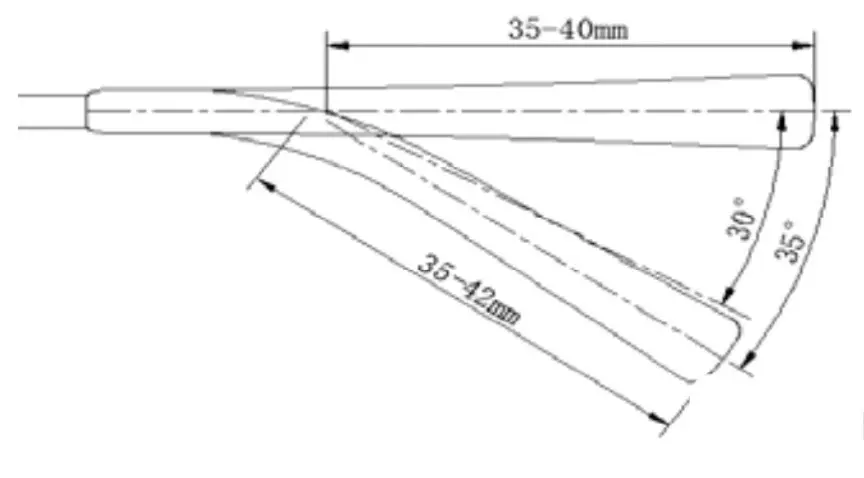

5.6 Calculating the pantoscopic angle of the eyeglass frame
Pantoscopic angle of the eyeglass frame refers to the angle between the straight line from the center point of the temple and temple tip joint to the “attachment point above the ear (OBS)” and the “normal line” of the lens. Since the “attachment point above the ear” and the “normal line” of the lens remain fixed when wearing the eyeglass frame, the position of the temple’s joint with the temple tip determines the temple tilt. The higher the end piece position, the greater the pantoscopic angle.
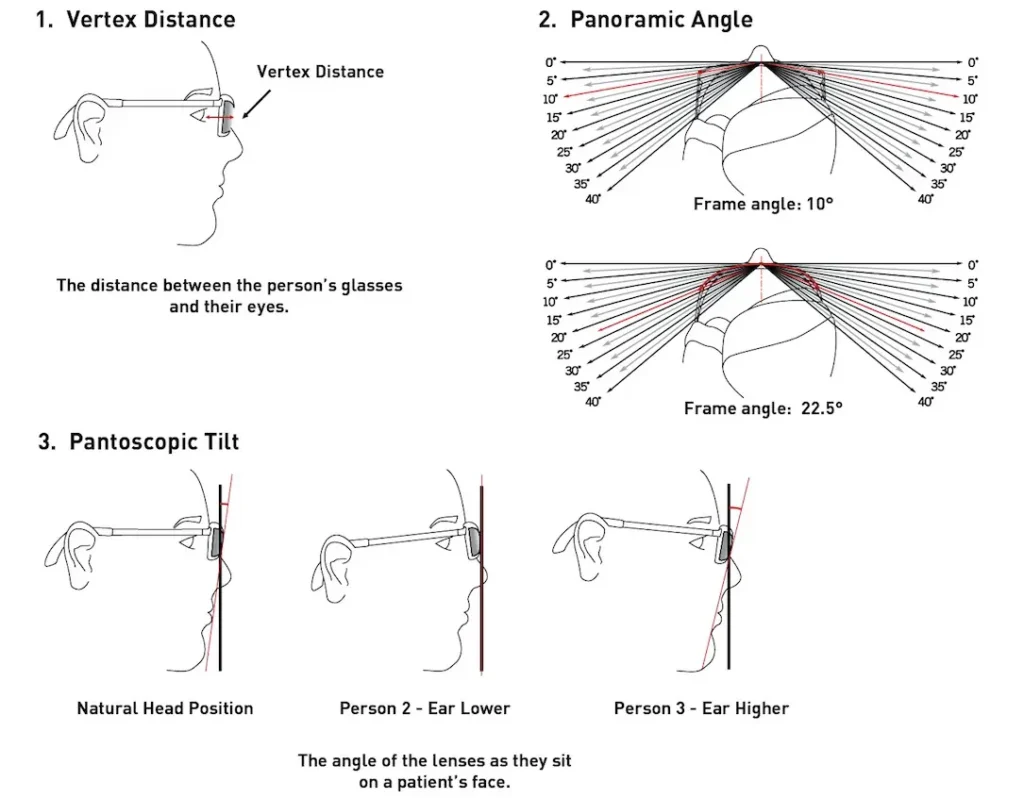
Please note:
- The front frame tilt conforms to the slant of the upper and lower edges of the eye socket on the side view of a person’s head.
- The pantoscopic angle is directly related to the position of the temple tip on the eyeglass frame; the higher the end piece, the greater the pantoscopic angle. (During sunglasses production, the size marked on the drawings and the actual measured size in production usually represent the pantoscopic angle.)
- The pantoscopic angle should be accurately calculated during the designing sunglasses process, as most eyeglass frames have non-adjustable angle. The strength of the temple tip is a crucial part of the overall frame strength. If the frame pantoscopic angle can be adjusted, it could indicate that the overall strength of the frame is insufficient, making it prone to deformation when worn. Besides, adjusting the pantoscopic angle might lead to the temple tip losing color or plier marks appearing.
5.7 Process and tools for eyewear designing
5.7.1 Sunglasses Sketch : The development of a product and designing sunglasses does not come from nothing or without reason; it is always the result of thorough market research and analysis of popular trends within a specific framework. Our designs revolve around the overarching framework of a brand, with the brand style and elements remaining relatively constant. First, we create sketches based on the brand’s style and tone using tools like mechanical pencils and curve boards. An example is shown in the image below:

5.7.2 Import the sketches into sunglass design software CorelDRAW (CDR) or Adobe Illustrator (AI) to develop a more accurate two-dimensional design draft.
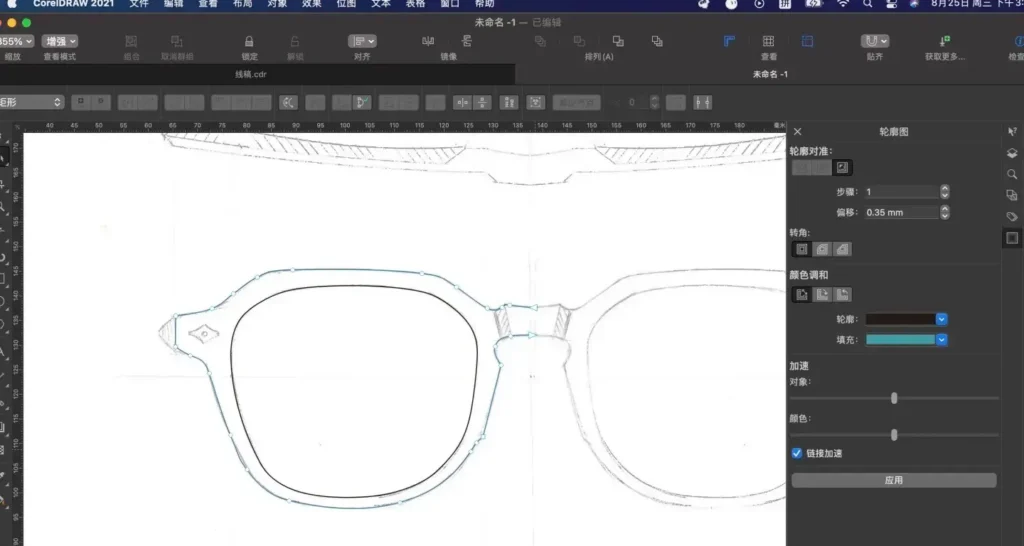
Once the linework is sketched, the mechanical process of drawing occurs, as shown in the complete image below:

5.7.3 Transfer to eyewear design software Photoshop (PS) to add color to the product.
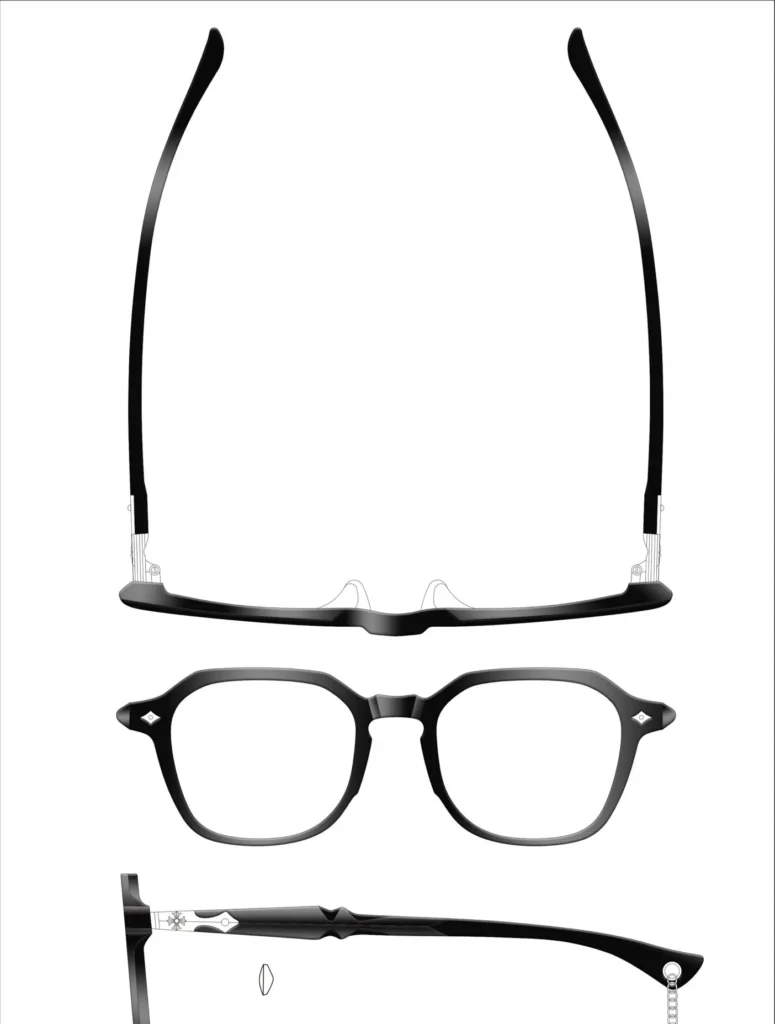
5.7.4 Make 3D drawings
5.8 Other considerations in eyeglass design
5.8.1 Material selection: Ensure compliance with the legal requirements of different regions, making sure the materials are non-toxic and harmless. Refer to the REACH regulation.
5.8.2 Frame strength: Eyeglass frames can become deformed after being worn for a period of time, which may be caused by insufficient frame strength. During the design process, it is important to assess frame strength. (For more details, see the eyeglass frame testing instructions in the following chapter.)
6. Spectacle frame test items
When we designing own glasses and create our own sunglasses brand, or prepare for work to design glasses and sell them, we must understand the sunglasses quality standards and inspection methods of glasses. The most basic quality standard ISO 12870-2016 (PDF) that we often mention must be very clear, which is more conducive to improving one’s professionalism for eyewear design and cooperation in sunglasses production when communicating with manufacturers in the future.
- Construction
- General physiological compatibility
- Nickel release
- Clinical evaluation
- Measurement system
- Dimensional tolerances on nominal size
- Tolerance on screw threads
- Dimensional stability at elevated temperature
- Resistance to perspiration
- Mechanical stability
- Resistance to ignition
- Resistance to optical radiation
7. 80 essential resource websites for designing sunglasses
How to complete a successful design? For designers, in addition to clever design ideas, design resources are also essential. How can we quickly find these design resources and improve work efficiency? In this article, I have compiled 60 brand design inspiration resource websites for you. Because having these effective resources will greatly improve work efficiency, it often has the effect of getting twice the result with half the effort.
You can quickly and easily get the inspiration, design styles, etc. you need from these resource websites, or they can be used as a reference, which will be of great help to your design.
2020 Europe Eyewear Magazine brings you the latest trends, styles, and innovations in the world of eyewear. Discover the captivating designs that blend fashion and functionality seamlessly. From sleek and modern frames to timeless classics, our magazine showcases the best eyewear brands and collections.
Dive into insightful articles on optical technology, lens advancements, and the art of frame craftsmanship. Stay ahead of the fashion curve and explore the eyewear industry’s dynamic landscape through the pages of 2020 Europe Eyewear Magazine.
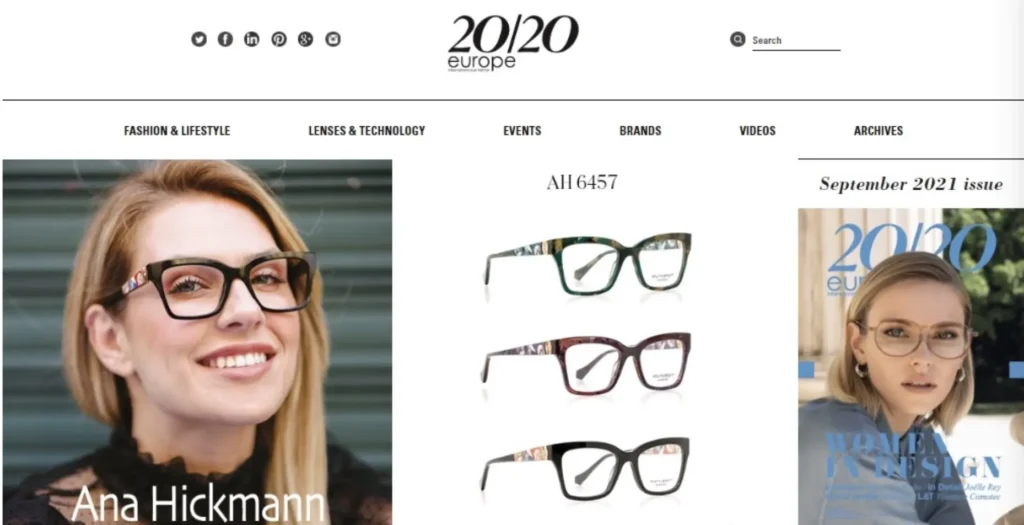
7.4 Blink magazine
Blink magazine is a captivating publication that celebrates the art of photography and visual storytelling. With each issue, Blink takes readers on a visual journey, showcasing stunning images from photographers around the world. From breathtaking landscapes to intimate portraits, the magazine captures the essence of the human experience through the lens.
Dive into thought-provoking articles that delve into the creative process, explore photography techniques, and highlight emerging talents. Whether you’re a photography enthusiast or simply appreciate the beauty of imagery, Blink magazine will inspire and engage you with its captivating visuals and compelling narratives.
7.5 EYE-BOOK
7.6 Eyecare Business

7.7 LYF magazine
7.8 Eyestylist
Eyezonemag Magazine is a cutting-edge publication that explores the world of fashion, beauty, and lifestyle through a unique lens. With a focus on diversity, creativity, and innovation, the magazine brings you the latest trends, exclusive interviews, and in-depth features on influential individuals and brands.
From runway fashion to street style, Eyezonemag Magazine captures the essence of contemporary culture and offers fresh perspectives on style and self-expression. With stunning visuals and compelling content, it is a must-read for fashion-forward individuals seeking inspiration and a deeper understanding of the ever-evolving world of fashion and lifestyle.
7.10 TEF Magazine
7.11 LOFT eyewear
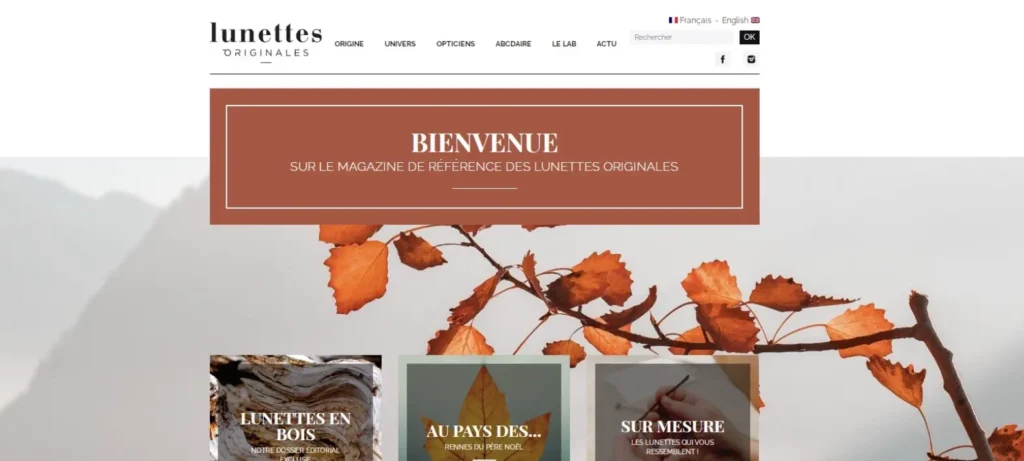
7.13 Mi Vision Magazine
Opticaljournal Magazine is a premier publication dedicated to the optical industry. It covers a wide range of topics related to eyewear, vision care, and the latest advancements in optical technology. From fashion-forward eyewear trends to in-depth articles on eye health, Opticaljournal Magazine provides valuable insights for eyecare professionals and enthusiasts alike.
Discover interviews with industry leaders, expert opinions on industry challenges, and informative articles on topics such as lens technology, frame design, and emerging optical innovations. With its comprehensive coverage and authoritative voice, Opticaljournal Magazine is an essential resource for staying informed and inspired in the dynamic world of optics.
7.15 100percentoptical
7.16 Ahlem eyewear
7.17. Aalexander daas

7.18. Anna karin karlsson
7.19. Andy-wolf
7.20 Articleone eyewear
Article One Eyewear is a renowned brand that combines style, craftsmanship, and social responsibility in its collection of premium eyewear. With a commitment to quality and sustainability, Article One creates timeless designs that transcend trends and stand the test of time. Each pair of glasses is meticulously handcrafted using the finest materials, ensuring both comfort and durability.
The brand’s attention to detail extends beyond aesthetics, as it actively supports charitable organizations focused on vision-related causes. By choosing Article One Eyewear, you not only elevate your style but also contribute to the greater good. Experience the perfect fusion of fashion and philanthropy with Article One Eyewear.
7.21. Bold-optical
7.22. Barton perreira
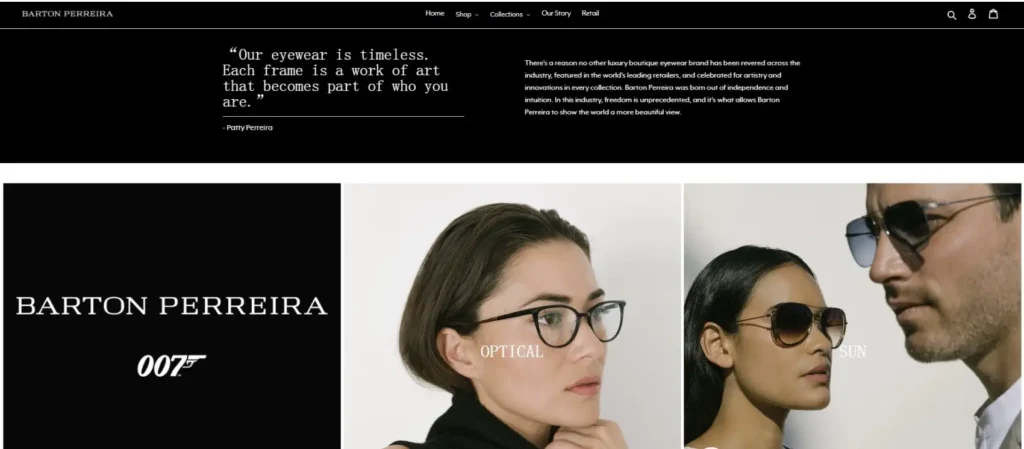
7.23. Bellinger
7.24. Bevel specs
7.25. Blac
Blac is a renowned eyewear brand that specializes in creating avant-garde and innovative eyewear designs. With a focus on pushing boundaries and challenging conventional norms, Blac offers a range of frames that are both visually striking and technologically advanced. Each pair of Blac glasses is meticulously crafted using high-quality materials such as titanium, ensuring durability and comfort.
The brand’s commitment to innovation is exemplified through its use of 3D printing technology, allowing for intricate and customized designs. Blac eyewear is a testament to boldness, individuality, and cutting-edge style, making it a coveted choice for those who dare to express themselves through their eyewear.
7.26. Blackfin
7.27. Blake kuwahara
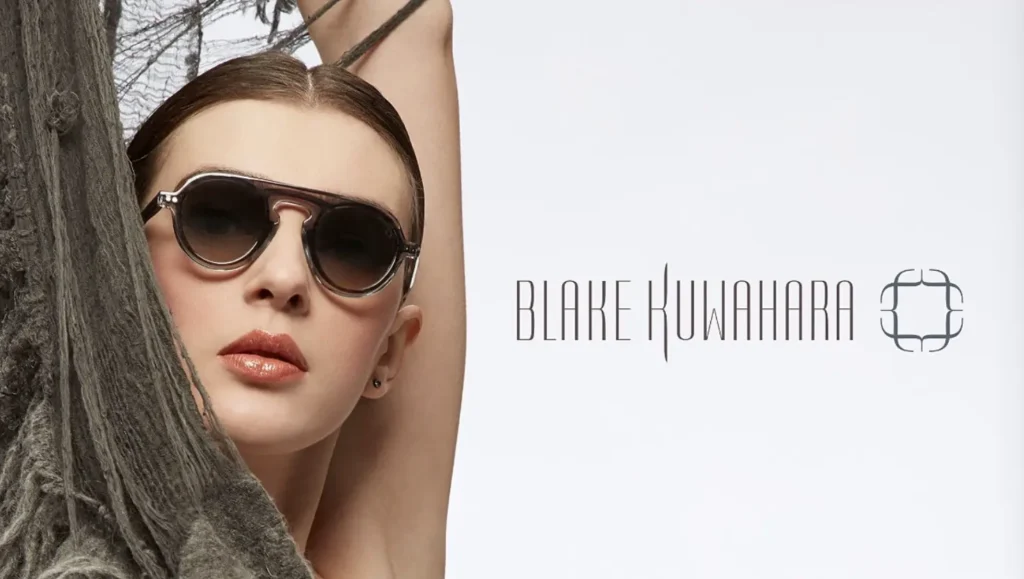
7.28. Boothand bruce
7.29. Bruno chaussignand
7.30. Bywp
Blac is a renowned eyewear brand that specializes in creating avant-garde and innovative eyewear designs. With a focus on pushing boundaries and challenging conventional norms, Blac offers a range of frames that are both visually striking and technologically advanced. Each pair of Blac glasses is meticulously crafted using high-quality materials such as titanium, ensuring durability and comfort.
The brand’s commitment to innovation is exemplified through its use of 3D printing technology, allowing for intricate and customized designs. Blac eyewear is a testament to boldness, individuality, and cutting-edge style, making it a coveted choice for those who dare to express themselves through their eyewear.
7.31. Hoet
7.32. Carlottas village
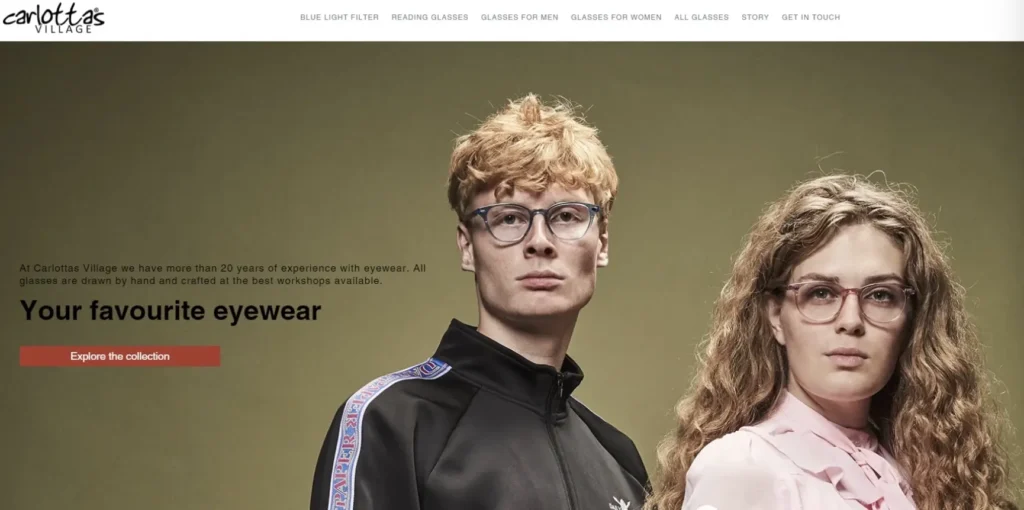
7.33. Caroline Abram
7.34. Sunshades eyewear
7.35. Cartier
Cartier eyewear represents the epitome of luxury and elegance. As an iconic brand renowned for its craftsmanship and timeless designs, Cartier offers a collection of eyewear that exudes sophistication and refinement. Each pair of Cartier glasses is meticulously crafted with attention to detail, using the finest materials and incorporating the brand’s signature aesthetic elements.
From classic aviators to modern cat-eye frames, Cartier eyewear showcases a harmonious blend of style and functionality. With their exquisite craftsmanship and iconic Cartier motifs, such as the Panthère or the Double C logo, Cartier eyewear captures the essence of luxury and provides a statement-making accessory for those with discerning taste.
7.36. Catherine de medici
7.37. Catuma eyewear
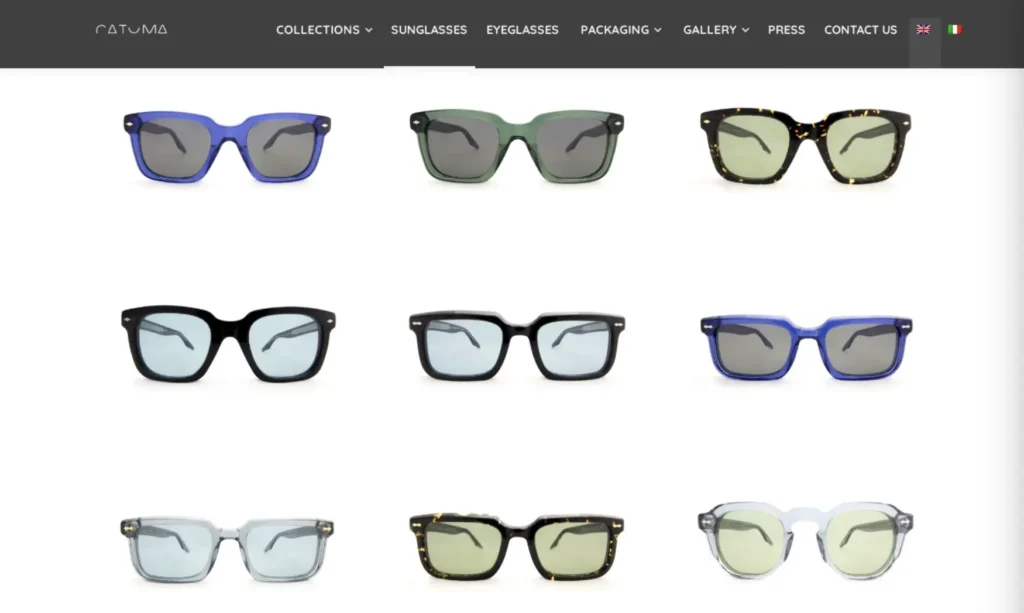
7.38. Chromehearts eyewear
7.39. Colibris
Colibris is a well-known eyewear brand that specializes in creating sustainable and eco-friendly eyewear. With a strong focus on environmental consciousness, Colibris offers a range of stylish frames made from recycled materials, such as recycled plastic bottles and reclaimed wood. The brand is committed to reducing its carbon footprint and promoting sustainability throughout its production process.
Colibris eyewear combines fashion-forward designs with a responsible approach, allowing individuals to express their style while making a positive impact on the planet. By choosing Colibris, you can enjoy fashionable and eco-friendly eyewear that aligns with your values.
7.40. Davettes
7.41. Delirious eyewear
7.42. Derapage-eyewear

7.43. Dilem
7.44. Dita
Dita is a highly esteemed luxury eyewear brand known for its exceptional craftsmanship and timeless designs. Founded in 1995, Dita has gained worldwide recognition for its meticulous attention to detail and commitment to producing handcrafted eyewear of the highest quality. Each pair of Dita glasses is meticulously crafted by skilled artisans, utilizing premium materials such as acetate, titanium, and 18k gold.
The brand’s designs often draw inspiration from vintage aesthetics, blending classic elements with modern innovation. Dita eyewear exudes sophistication, elegance, and a sense of understated luxury, making it a preferred choice for those seeking exquisite and distinctive eyewear.
7.45. Dokomotto
7.46. Dolpi
7.47. EK eyewear

7.48. Eof7
7.49. Etniabarcelona
Etnia Barcelona is a renowned eyewear brand celebrated for its vibrant designs and commitment to creativity. Established in Barcelona, Spain, in 2003, the brand has gained a reputation for its bold use of color, unique patterns, and innovative frame shapes. Etnia Barcelona frames are crafted with meticulous attention to detail, utilizing high-quality materials such as acetate and stainless steel for durability and comfort.
The brand takes pride in its diverse range of styles, offering eyewear that appeals to individuals seeking distinctive and expressive looks. Etnia Barcelona’s commitment to sustainability is also evident through its use of eco-friendly materials and socially responsible manufacturing practices. With its fusion of art, fashion, and culture, Etnia Barcelona eyewear allows wearers to make a bold statement and embrace their individuality.
7.50. Exalto
7.51. FaceaFace
7.52. Fakoshima eyewear
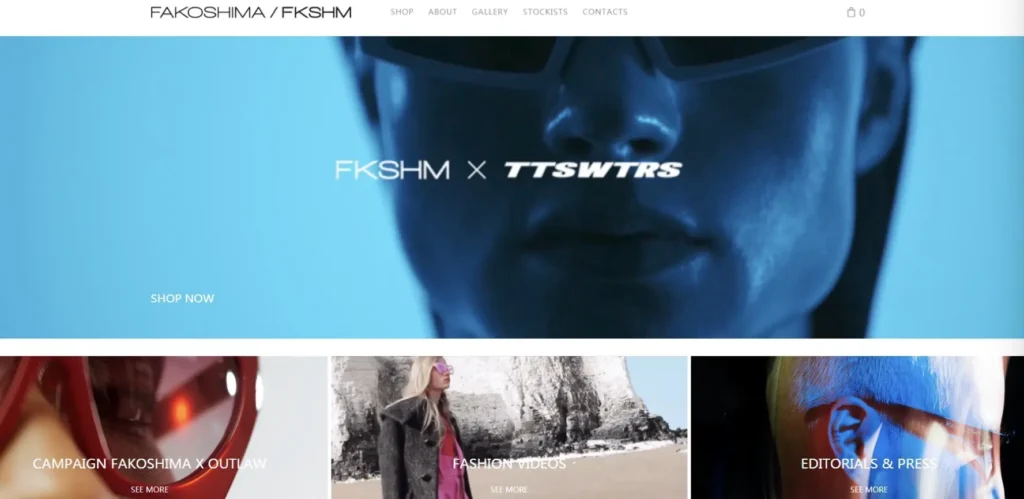
7.53. Falvin eyewear
7.54. Feb31
Feb31 is an independent Italian eyewear brand known for its exquisite handmade wooden frames. Established in 2009, Feb31 combines traditional craftsmanship with innovative design to create unique and personalized eyewear pieces. The brand offers a wide range of frame shapes and styles, allowing customers to choose from a variety of wood types, colors, and finishes.
Each Feb31 frame is meticulously crafted using sustainable materials and precise manufacturing techniques. The brand’s dedication to sustainability extends to its eco-friendly production processes and commitment to minimizing waste. Feb31 eyewear is not only a stylish accessory but also a testament to the brand’s passion for quality, craftsmanship, and environmental consciousness.
7.55. Fh one
7.56. Fleye copenhagen
7.57. Francis klein
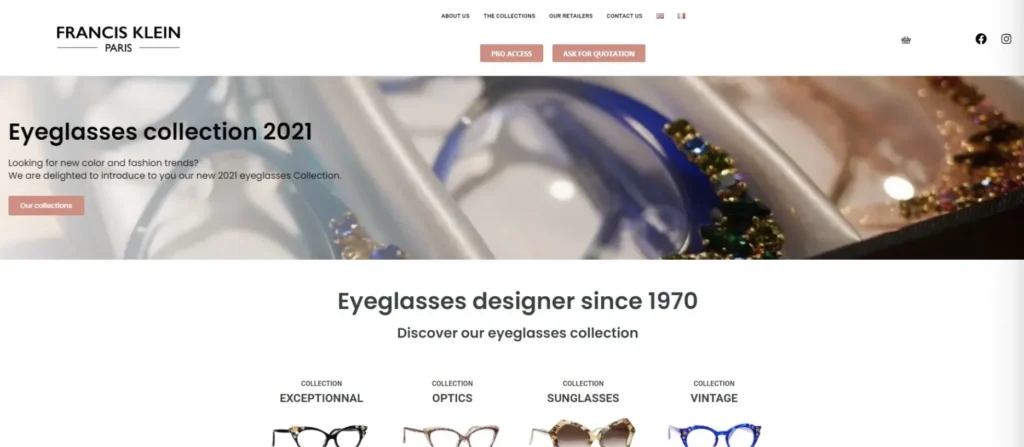
7.58. Fred
Fred is a renowned French eyewear brand known for its innovative designs, luxurious materials, and exceptional craftsmanship. Founded in 1936, Fred has established itself as an iconic name in the eyewear industry, offering a range of eyeglasses and sunglasses that blend elegance with contemporary style.
The brand is recognized for its distinctive use of precious metals, such as gold and platinum, as well as unique design elements, including the signature “Cable” motif inspired by nautical ropes. Fred eyewear embodies sophistication and luxury, making it a sought-after choice for individuals who appreciate refined aesthetics and impeccable quality.
7.59. Equem eyewear
7.60. Fritz frames
7.61. Falvineyewear
7.62. Feb31 frames

7.63. Flair eyewear
7.64. Fleye frames
7.65. Frames Direct
FramesDirect is an online retailer specializing in eyewear, including prescription glasses, sunglasses, and contact lenses. As one of the leading online optical retailers, FramesDirect offers a wide selection of frames from various well-known brands, including designer and luxury eyewear. Customers can browse through a vast range of styles, shapes, and materials to find the perfect eyewear that suits their preferences and needs.
FramesDirect also offers the convenience of online prescription ordering, allowing customers to easily enter their prescription information and customize their lenses. With a focus on quality, customer service, and competitive pricing, FramesDirect has become a popular destination for purchasing eyewear online.
7.66. Gentle Monster
7.67. Gold Wood frames

7.68. Gucci eyewear
7.69. ic-berlineyewear
IC! Berlin Eyewear is a German eyewear brand known for its minimalist designs and innovative construction techniques. Founded in 1996 in Berlin, the brand has gained recognition for its lightweight and screwless frames. IC! Berlin frames are typically made from high-quality stainless steel sheet material, which is laser-cut and then handcrafted into unique and durable eyewear pieces.
The screwless hinge system is a trademark feature of IC! Berlin, ensuring flexibility, stability, and easy maintenance. With a focus on clean lines, sleek aesthetics, and attention to detail, IC! Berlin Eyewear offers a modern and distinctive eyewear collection that combines style, comfort, and functionality.
7.70. international eyewear
7.71. italee frames
7.72. iwaki optic
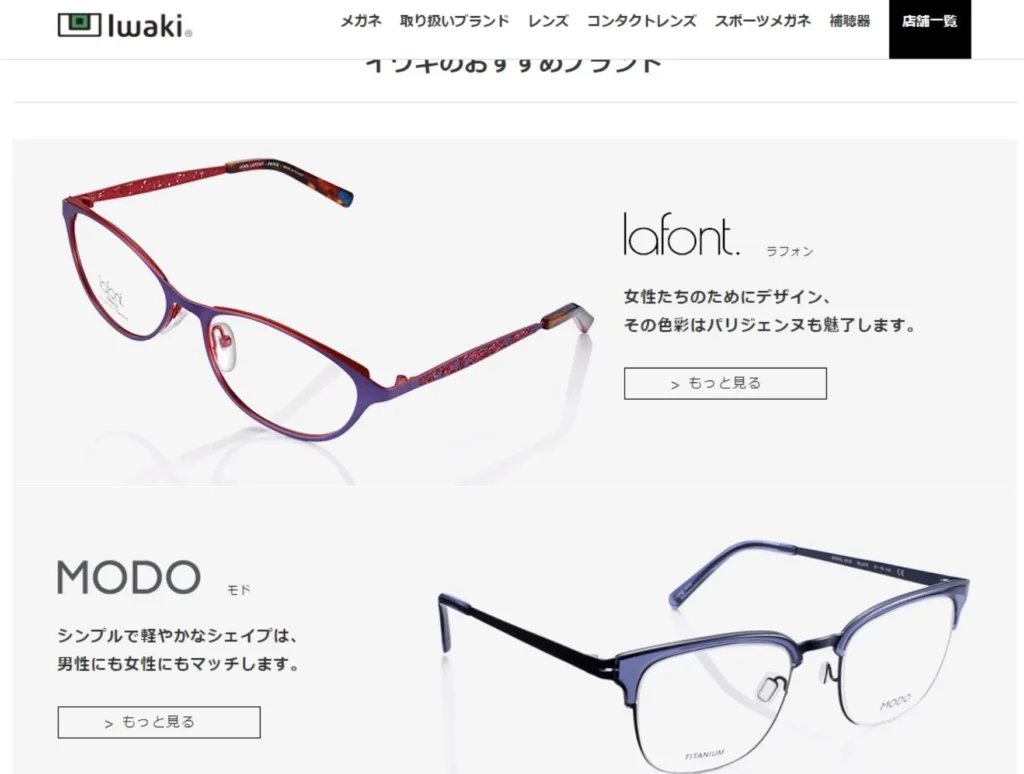
7.73. Jepoque frames
7.74 Woods Eyewear
Woods Eyewear is a brand that specializes in creating eyewear frames made from sustainable wood materials. They offer a unique and eco-friendly alternative to traditional eyewear. The frames are crafted using various types of wood, such as bamboo, walnut, ebony, and zebrawood. Each frame is meticulously handcrafted, resulting in individual variations and a distinctive natural aesthetic. Woods Eyewear frames are lightweight, comfortable, and designed for optimal fit.
The use of wood as a material allows for flexibility in design, resulting in frames with unique textures and patterns. The brand is committed to sustainability and often partners with environmental organizations and supports reforestation projects. Woods Eyewear provides a stylish and environmentally conscious choice for individuals seeking eyewear that combines fashion and sustainability.
7.75. La giardiniera frames
7.76. Lamatta eyewear
7.77. LEECH frames

7.78. RecSpecs frames
7.79. lineart-charmant eyewear
LineArt Charmant Eyewear is a brand known for its innovative and sophisticated designs. They combine Japanese craftsmanship with advanced technology to create lightweight, durable, and elegant frames. Their frames are made with the exclusive “Screwless Alpha Titanium” material, which eliminates the need for screws and provides a sleek and minimalist aesthetic. The frames feature clean lines, slim profiles, and subtle details, offering a range of styles from classic to contemporary.
LineArt Charmant pays great attention to detail and quality, ensuring precise craftsmanship and meticulous finishing. They are also committed to sustainability, using eco-friendly materials and implementing environmentally conscious practices. LineArt Charmant Eyewear offers a stylish and high-quality option for those seeking innovative and sophisticated eyewear.
7.80. luxottica

8.The role of hand drawing in designing glasses
Hand drawn eyewear sketches are crucial in the eyewear design process. The main goal of industrial design hand-drawing is to be fast, efficient and accurate. Good hand-drawing of glasses is a way to quickly express the designer’s creative ideas. The larger the project, the more it is necessary for the eyewear designer to confirm multiple solutions in advance to avoid mistakes in the design direction, which will lead to wasting time and energy on useless work. At this time, the sketch will greatly reflect its value.
9.Conclusion
In summary, designing sunglasses is a creative and fulfilling process that involves several key steps. To learn how to design sunglasses or create your own unique pair, it’s essential to understand the various aspects involved in the design process. By following a comprehensive guide on designing your own sunglasses, you’ll be better equipped to bring your vision to life and even learn how to make your own sunglasses from scratch.
Whether you’re a seasoned designer or just starting, the journey of designing sunglasses begins with inspiration and understanding the target audience. From there, create sketches of your concepts, and use digital tools like Adobe Illustrator or CorelDRAW to refine your ideas into precise two-dimensional designs. Transferring your designs to Photoshop allows for the addition of color, texture, and other visual elements. Don’t forget to consider factors like material selection, compliance with regulations such as REACH, and frame strength to ensure a durable and high-quality final product.
Embrace the opportunity to design your own sunglasses and explore the endless possibilities of creating a unique and stylish accessory that reflects your personal taste and style.